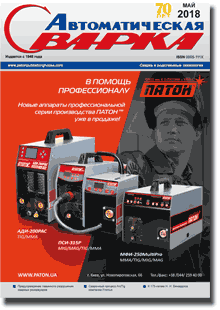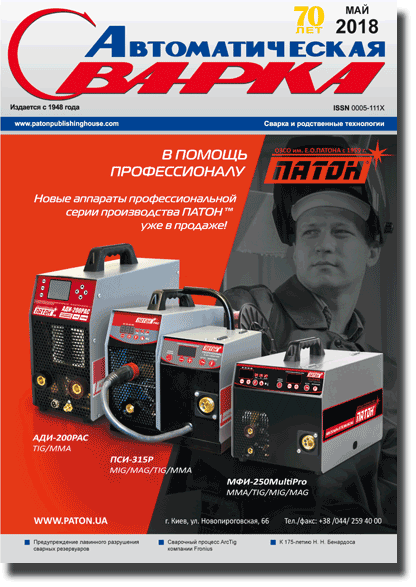| 2018 №05 (05) |
DOI of Article 10.15407/as2018.05.06 |
2018 №05 (07) |

Avtomaticheskaya Svarka (Automatic Welding), # 5, 2018, pp. 34-38
Influence of electric parameters of surfacing with discrete filler in current-supplying mould on velocity of slag pool rotation
Yu.M. Kuskov
E.O. Paton Electric Welding Institute of the NAS of Ukraine. 11 Kazimir Malevich Str., 03150, Kyiv, Ukraine. E-mail: office@paton.kiev.ua
Application of the most promising surfacing material — discrete filler makes a significant difference in the processes of surfacing with current-supplying mould. Influence of surfacing current and electric power applied to the slag pool, on its angular velocity of rotation at application of three commercial flux grades was studied. It is found that NAF-29 flux allows producing a sufficiently large rotating effect both during the period of slag pool formation, and during surfacing. ANF-32 flux is less effective during the period of sag pool formation. AN-26 flux provides active rotation of the slag pool during surfacing, but this requires applying higher electric power to the pool. Angular velocity of slag pool rotation is affected both by electric power applied to the slag pool, and surfacing current, but the latter has a determinant influence. 16 Ref., 1 Tabl., 2 Fig.
Keywords: electroslag surfacing, current-supplying mould, fluxes, slag pool, angular velocity of slag rotation, surfacing current, electric power, discrete filler
Received: 12.01.2018
Published: 24.04.2018
References
1. Vachugov, G.A., Chumanov, V.I., Khasin, G.A. et al. (1975) Influence of rotation of remelted electrode on electroslag remelting process. Problemy Spets. Elektrometallurgii, 28, 31–36 [in Russian].
2. Kodama, H., Kandro, I., Akahori, K. et al. (1987) Properties of cladded rolls produced by method of electroslag surfacing with rotation. In: Proc. of 8th Intern. Conf. on Vacuum Metallurgy, Special Kinds of Surfacing and Metallurgical Coatings, 9, 139–145.
3. Maksimovich, B.I. (1962) Effect of electromagnetic rotation of slag pool on crystallization of metal in electroslag remelting of high-alloy steels and alloys. Elektrotermiya, 5, 9–12 [in Russian].
4. Topilin, V.V., Klyuev, M.M., Fomicheva, N.P., Grebtsov, Yu.G. (1968) Refining of macrostructure of ingots in electroslag remelting of alloys. Problemy Spets. Elektrometallurgii, 1, 23–28 [in Russian].
5. Kudelkin, V.P., Klyuev, M.M., Filippov, S.I. et al. (1969) Impact of ultrasonic oscillations on crystallization in electroslag remelting. Vuzov. Chyorn. Metallurgiya, 11, 64–70 [in Russian].
6. Ksyondzyk, G.V. (1975) Current-supplying mold insuring rotation of slag pool. Problemy Spets. Elektrometallurgii, 27, 33–40 [in Russian].
7. Podgaetsky, V.V., Kuzmenko, V.G. (1988) Welding fluxes: Book. Kiev, Naukova Dumka [in Russian].
8. Ksyondzyk, G.V., Frumin, I.I., Shirin, V.S. (1964) Currentsupplying mold. USSR author's cert. 264427 [in Russian].
9. Ksyondzyk, G.V., Frumin, I.I., Shirin, V.S. (1969) Device for electroslag remelting. USSR author's cert. 337026 [in Russian].
10. Kuskov, Yu.M. (1969) Electroslag surfacing of cylindrical billets with liquid filler material in current-supplying mold. Svarka, 6, 52–53 [in Russian].
11. Medovar, B.I., Chernets, A.V., Medovar, L.B. et al. (1995) Electroslag surfacing with liquid filler metal. Problemy Spets. Elektrometallurgii, 1, 6–11 [in Russian].
12. Tsykulenko, A.K., Lakuman, I.A., Medovar, L.B. et al. (2000) Two-loop circuit of electroslag remelting of consumable electrode. , 3, 16–20 [in Russian].
13. Sokolov, G.N., Lysak, V.I. (2005) Surfacing of wear-resistant alloys on press tools and instruments for hot forming of steels. Volgograd, RPK Politekhnik [in Russian].
14. Sokolov, G.N. Zorin, I.V., Tsurikhin, S.N. (2004) Technology of electroslag surfacing of mandrels of tube-rolling unit. Svarshchik, 1, 15 [in Russian].
15. Sokolov, G.N. (2007) Formation of composite structure of deposited metal for operation in thermoslag impact conditions and development of ESS of press tools and instruments: Syn. of Thesis for Dr. of Techn. Degree. Volgograd [in Russian].
16. Kuskov, Yu.M. (2018) Influence of flux composition on the process of electroslag surfacing of end faces with discrete feeding of filler material. The Paton Welding J., 1, 33–37. https://doi.org/10.15407/tpwj2018.01.07
The cost of subscription/purchase order journals or individual articles
| Journal/Currency | Annual Set | 1 issue printed |
1 issue |
one article |
| TPWJ/USD | 384 $ | 32 $ | 26 $ | 13 $ |
| TPWJ/EUR | 348 € | 29 € | 24 € | 12 € |
| TPWJ/UAH | 7200 UAH | 600 UAH | 600 UAH | 280 UAH |
| AS/UAH | 1800 UAH | 300 UAH | 300 UAH | 150 UAH |
| AS/USD | 192 $ | 32 $ | 26 $ | 13 $ |
| AS/EUR | 180 € | 30 € | 25 € | 12 € |
| SEM/UAH | 1200 UAH | 300 UAH | 300 UAH | 150 UAH |
| SEM/USD | 128 $ | 32 $ | 26 $ | 13 $ |
| SEM/EUR | 120 € | 30 € | 25 € | 12 € |
| TDNK/UAH | 1200 UAH | 300 UAH | 300 UAH | 150 UAH |
| TDNK/USD | 128 $ | 32 $ | 26 $ | 13 $ |
| TDNK/EUR | 120 € | 30 € | 25 € | 15 € |
AS = «Automatic Welding» - 6 issues per year;
TPWJ = «PATON WELDING JOURNAL» - 12 issues per year;
SEM = «Electrometallurgy Today» - 4 issues per year;
TDNK = «Technical Diagnostics and Non-Destructive Testing» - 4 issues per year.





